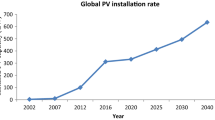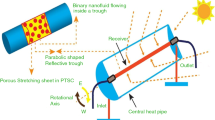Abstract
The paper presents the effect of the Reynolds number, relative roughness height and relative roughness pitch on the heat transfer and pressure loss in a solar air heater. A novel absorber plate with metal shavings from the turning of a steel shaft is employed to reduce the cost of production and to be available for the manufacturing industry. The parameters studied ranged from 5000 to 25000 for the Reynolds number, from 4.7 to 9.4 for the relative roughness pitch (P/e) and from 0.26 to 0.43 for the relative roughness height (e/Dh). The results show that there are some characteristics that differ from the published studies. The optimum e/Dh is 0.35 to obtain the highest thermo-hydraulic performance parameter, and the parameter increases with a decrease in P/e. Within the scope of the study, the maximum thermo-hydraulic performance parameter is approximately 1.5. The correlations between the Nusselt number and the friction factor are developed based on the experimental data. The results from the correlations and from the experimental data are fairly in agreement.
Similar content being viewed by others
References
B. Baulch, T. D. Do and T. H. Le, Constraints to the uptake of solar home systems in Ho Chi Minh City and some pro posals for improvement, Renewable Energy, 118) (2018) 245–256.
S. H. Farjana, N. Huda, M. A. P. Mahmud and R. Saidur, Solar process heat in industrial systems–A global review, Renewable and Sustainable Energy Reviews, 82 (3) (2018) 2270–2286.
S. V. Karmare and A. N. Tikekar, Heat transfer and friction factor correlation for artificially roughened duct with metal grit ribs, International Journal of Heat and Mass Transfer, 50 (21-22) (2007) 4342–4351.
A. Lanjewar, J. L. Bhagoria and R. M. Sarviya, Experimental study of augmented heat transfer and friction in solar air heater with different orientations of W-Rib roughness, Experimental Thermal and Fluid Science, 35 (6) (2011) 986–995.
K. Kumar, D. R. Prajapati and S. Samir, Heat transfer and friction factor correlations development for solar air heater duct artificially roughened with ‘S’ shape ribs, Experimental Thermal and Fluid Science, 82 (2017) 249–261.
V. S. Hans, R. S. Gill and S. Singh, Heat transfer and friction factor correlations for a solar air heater duct roughened artificially with broken arc ribs, Experimental Thermal and Fluid Science, 80 (2017) 77–89.
S. N. Saha and S. P. Sharma, Performance analysis of double-flow double-exposure solar air heater, Journal of Mechanical Science and Technology, 32 (3) (2018) 1407–1414.
R. Kumar, V. Geol and A. Kumar, A parametric study of the 2D model of solar air heater with elliptical rib roughness using CFD, Journal of Mechanical Science and Technology, 31 (2) (2017) 959–964.
R. Kumar, V. Goel, A. Kumar, S. Khurana, P. Singh and S. B. Bopche, Numerical investigation of heat transfer and friction factor in ribbed triangular duct solar air heater using computational fluid dynamics (CFD), Journal of Mechanical Science and Technology, 32 (1) (2018) 399–404.
I. Singh and S. Singh, CFD analysis of solar air heater duct having square wave profiled transverse ribs as roughness elements, Solar Energy, 162) (2018) 442–453.
S. Kumar and R. P. Saini, CFD based performance analysis of a solar air heater duct provided with artificial roughness, Renewable Energy, 34 (5) (2009) 1285–1291.
D. S. Thakur, M. K. Khan and M. Pathak, Performance evaluation of solar air heater with novel hyperbolic rib geometry, Renewable Energy, 105) (2017) 786–797.
T. Alam and M. H. Kim, Heat transfer enhancement in solar air heater duct with conical protrusion roughness ribs, Applied Thermal Engineering, 126) (2017) 458–469.
A. González, J. Norambuena-Contreras, L. Storey and E. Schlangen, Self-healing properties of recycled asphalt mixtures containing metal waste: An approach through microwave radiation heating, Journal of Environmental Management, 214) (2018) 242–251.
A. Reyes, D. Negrete, A. Mahn and F. Sepúlveda, Design and evaluation of a heat exchanger that uses paraffin wax and recycled materials as solar energy accumulator, Energy Conversion and Management, 88 (2014) 391–398.
ASHRAE Standard 93–97, Method of Testing to Determine the Thermal Performance of Solar Collector (1977).
I. Singh and S. Singh, A review of artificial roughness geometries employed in solar air heaters, Renewable and Sustainable Energy Reviews, 92 (2018) 405–425.
ANSYS Inc., ANSYS 16.0 User’s Guide (2015).
Acknowledgments
This research is funded by the Vietnam National University Ho Chi Minh City (VNU-HCM) under grant number C2018-20-02.
Author information
Authors and Affiliations
Corresponding author
Additional information
Recommended by Associate Editor Youngsuk Nam
Nguyen Minh Phu received B.E. in 2006, and M.E. in 2009 from Ho Chi Minh City University of Technology (HCMUT), Vietnam, and Ph.D. from University of Ulsan, Korea in 2012. He had been with the Arizona State University at Tempe during the summer 2014 as exchange visitor. He has been a lecturer of Mechanical Engineering Faculty in HCMUT since 2006. His research interests include the design of thermal systems, the applied renewable energy and the CFD.
Vo Tuyen obtained his Ph.D. degree from Ho Chi Minh City University of Technology in 2014. He is currently serving as a Vice-rector of Ho Chi Minh city University of Food Industry (HUFI). His research interests include manufacturing engineering and turbulent two-phase flow.
Tu Thien Ngo received B.E. in 2012, and M.E. in 2014 from Ho Chi Minh City University of Technology (HCMUT), Vietnam, and Ph.D. from University of Ulsan, Korea in 2019. He has been a lecturer of Mechanical Engineering Faculty in HCMUT since 2013. His research interests include the CFD and the combustion.
Rights and permissions
About this article
Cite this article
Phu, N.M., Tuyen, V. & Ngo, T.T. Augmented heat transfer and friction investigations in solar air heater artificially roughened with metal shavings. J Mech Sci Technol 33, 3521–3529 (2019). https://doi.org/10.1007/s12206-019-0646-x
Received:
Revised:
Accepted:
Published:
Issue Date:
DOI: https://doi.org/10.1007/s12206-019-0646-x




